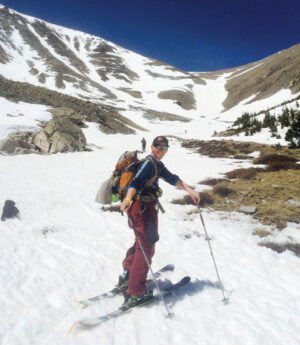By George Sibley
An interesting thing happened mid-March in Boulder which the media seem to have mostly missed. Commissioners from Grand County showed up at a noisy Boulder County commissioners’ hearing on a West Slope-to-East Slope transmountain water diversion project – to testify on behalf of the project. It is probably the first time ever, in the generally contentious history of Colorado water development, that the people in a basin of origin have supported a transmountain diversion project that people in the basin of destination oppose.
Although this is a story from just beyond our Central Colorado boundaries, it is a story of interest to anyone in the West who is wondering how, or even if, we are going to finally leave the 20th century and venture into the 21st and the Anthropocene Epoch we keep trying to pretend we haven’t brought on ourselves.
The report on the Boulder County hearing sounded like your usual 20th century public hearing on the kind of issue that seems almost structured to pit environmentalists against the developers of something or other – a hearing in which no one has to listen because everyone already knows what everyone else is going to say.
The issue in this case pits the usual Front Range environmental organizations against a public utility that everyone loved to hate through the 20th century, Denver Water (DW). DW wants to enlarge the Gross Dam and Reservoir it built in the 1950s in the foothills near Boulder, to hold some additional water it wants to import from the West Slope – its “Moffat Firming Project” which would bring a third more water on average through its Moffat Tunnel Project from the Fraser and Williams Fork Rivers in the Upper Colorado River watersheds.
The Gross expansion is not a small enlargement: DW wants to raise the height of the 340-foot dam another 131 feet, almost tripling the capacity of the reservoir, adding 77,000 acre-feet (af) to the current 41,800 af capacity. DW already holds a water right for the additional supply, but has no place on the Front Range to store it when it is available for diversion in the spring and early summer runoff.
[InContentAdTwo]
According to the report in the Boulder Daily Camera, scores of people testified in the four-hour hearing, virtually all of them opposing the enlargement with “impassioned pleas.” Many of them were associated with Boulder’s Environmental Group and the “Save the Colorado” organization. Their major argument is that DW ought to be able to obtain its “new water” for the future entirely through conservation – never mind that DW has already significantly reduced water consumption among its customers to where the utility is now only delivering the same quantity of water it was delivering in the late 1960s, but with half a million more customers. Denver is also developing a reuse system to maximize its use of transmountain diversions, but there’s probably a limit to the water you can squeeze out of a city.
The question underlying the hearing was whether the commissioners should invoke the County’s 1041 powers under the 1974 Areas and Activities of State Interest Act; this enables county governors to impose mitigation demands on large “special developments” above and beyond state and federal environmental or other mandates. DW claims that the Moffat Project and Gross Dam enlargement were approved prior to the 1974 law, and that it should therefore not apply; but following the hearing, the commissioners voted unanimously to invoke their power, raising the possibility that DW might take them to court over it.
What was missed in the Daily Camera report was a breeze from the 21st century: The brief testimony from Grand County Commissioners Merrit Linke and Rick Cimino. My information about this is from a friend who attended the hearing; the Camera noted only that Linke cautioned against a move that might lead to a “ton of litigation” from DW and others – possibly including Grand County.
But according to my source, Linke went on to caution all parties against “absolute answers,” and asked both sides to seek compromise solutions that will allow the project to go forward. So – a West Slope county asking a reluctant East Slope county to facilitate a transmountain diversion? How does this make sense?
Part of the answer to that is the “kinder, gentler Denver Water” that emerged after its big Two Forks Dam project was vetoed by the EPA in 1989. A 21st century Denver Water that finally understands that to take water from the West Slope incurs a moral responsibility to mitigate the loss to the West Slope. In the 1930s DW could legally – and did – just come take the Fraser River water to move it through the Moffat Railroad Tunnel pilot bore. But much had changed by the time they came back for the last of their decreed water in the early 2000s.
The second part of the answer is a changed attitude on the West Slope. When DW came the second time, knowing they would have to give something to get what they wanted, water leaders on the West Slope decided they would try negotiating rather than sounding the usual – and usually futile – “Not one drop!” battle cry.
So they negotiated – for five years, 2007-2012. It was Denver Water at the table with 40-some West Slope water users coalesced under the leadership of the Colorado River Water Conservation District: County governments, irrigation districts, water treatment districts, towns and cities – and environmentalists. The participation of Trout Unlimited, in the stubborn person of TU counsel Mely Whiting, became an important touchstone for the integrity of the process.
The result was the Colorado River Cooperative Agreement (CRCA), completed in 2012 – a very detailed document laying out specific benefits and responsibilities for each side of the Divide. To summarize, it allows DW to take its additional water from the West Slope only in years of average and above average precipitation, enough in those years to obtain the 17,000 af annual average it believes it will need. In exchange for that, DW has committed to develop strong conservation programs and continue developing its reuse system on the Front Range to get the most use possible out of the diverted water.
For the West Slope and Grand County, DW is both funding and actively participating in planning and executing a Learning by Doing process – essentially, an adaptive management process of active experimentation in learning how to live with less water. Some of it is more conventional work providing funding and expertise to water treatment districts and irrigation districts needing to use less water more efficiently.
But some of it will actually be what strikes me as “creative environmentalism”: Actually reconstructing some streams to function ecologically with a permanent reduction of water – call it “downsizing” the stream to fit the unignorable realities of the future. Channels are narrowed and deepened to cool the waters, helping both the aquatic ecosystem and the human economy of floaters and fishermen; riparian vegetation is planted to shade the stream and stabilize banks; meanders are induced to give a healthy stability and resilience for the foreseeable diminished future. Half a mile of the Fraser near U.S. 40 has been so ‘remodeled’ and is open to public inspection (and fishing). DW has committed millions to this work. (The CRCA can be found online by browsing for the name in full.)
To my mind, three visionaries are worth noting in this process. One has to be Chips Barry, who was Chief Executive Officer for Denver Water through most of the Cooperative Agreement process, and who had turned Denver Water around after the Two Forks defeat, from an arrogant and often bullying organization to an organization with needs, but a willingness to work creatively with those who had what it needed.
Another visionary is Mely Whiting of Trout Unlimited, an environmental organization that had a long history of antagonistic relations with Denver Water. But when DW appeared to be serious about giving a little to get a little, she jumped in hoping that DW could be persuaded to address some of the problems caused by past transmountain diversions in the Colorado River Basin as well as future. As an environmentalist, she said in an interview, “Our influence doesn’t have to be filing lawsuits – forming partnerships and having an inside influence can be just as effective and sometimes more productive.”
The third visionary would be Lurline Curran, Grand County Manager and the county’s head negotiator in the Cooperative Agreement. In April 2018, although retired by then, she wrote a guest editorial to the Daily Camera, in which she asked Boulder County residents to look at a larger picture beyond their own back yards: “The impacts that are associated with the construction of the Gross Reservoir Enlargement are substantial and one sympathizes with those who will experience them, but the reality is they will end. However, without the Cooperative Agreement, the impacts to the Fraser and Colorado rivers will continue with no hope of improvement.The loss of these enhancements and mitigation will doom the Fraser and Colorado rivers in Grand County to environmental catastrophe.”
One hopes there might be some creative way forward other than the 20th century “absolute answers” so passionately advocated in Boulder County in March, which would shut down the Firming Project. If Boulder’s 20th century environmentalists succeed in that, it may be a Pyrrhic victory.
George Sibley lives in Gunnison except when he’s trying to find the future. george@gard-sibley.org


